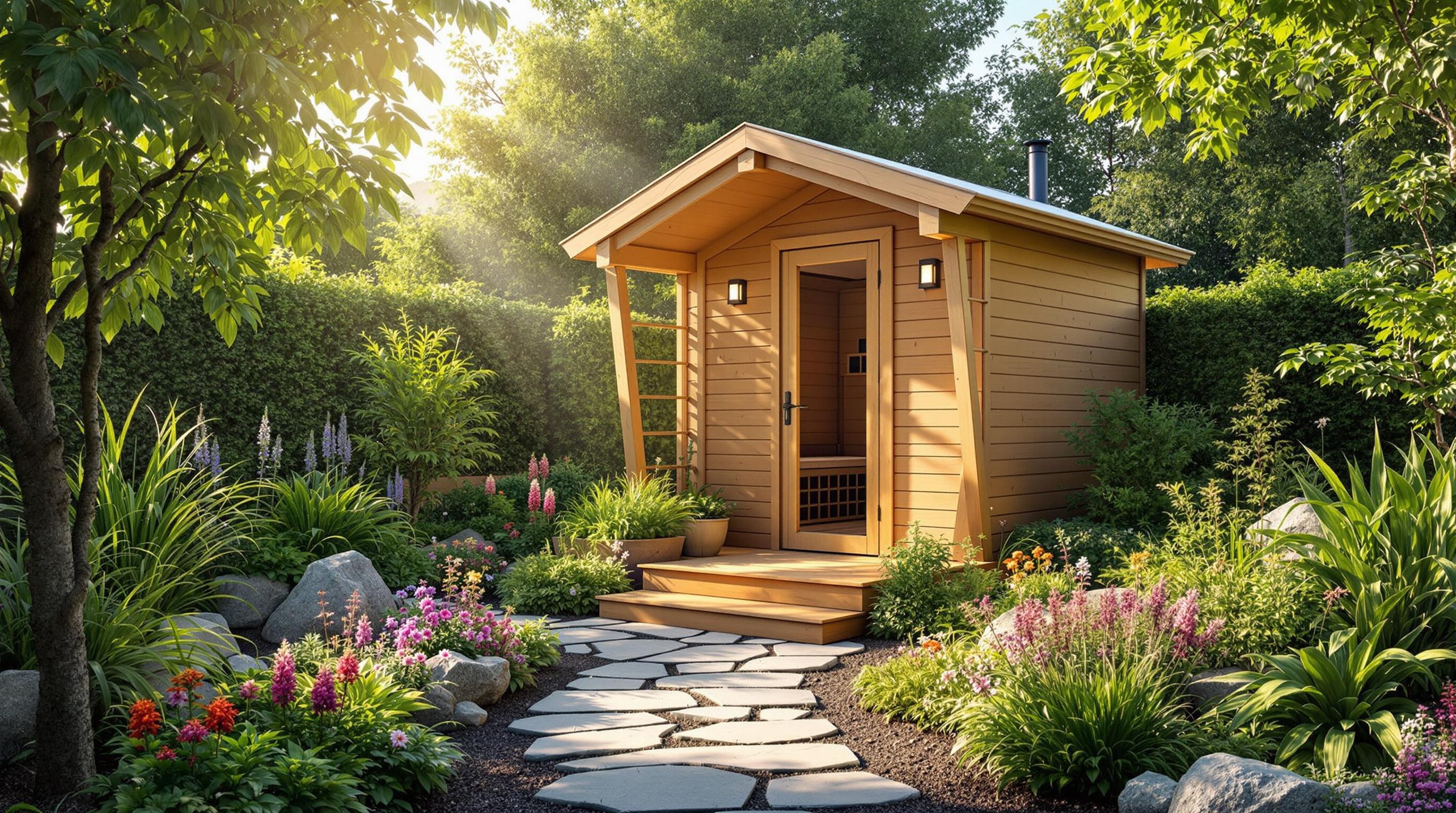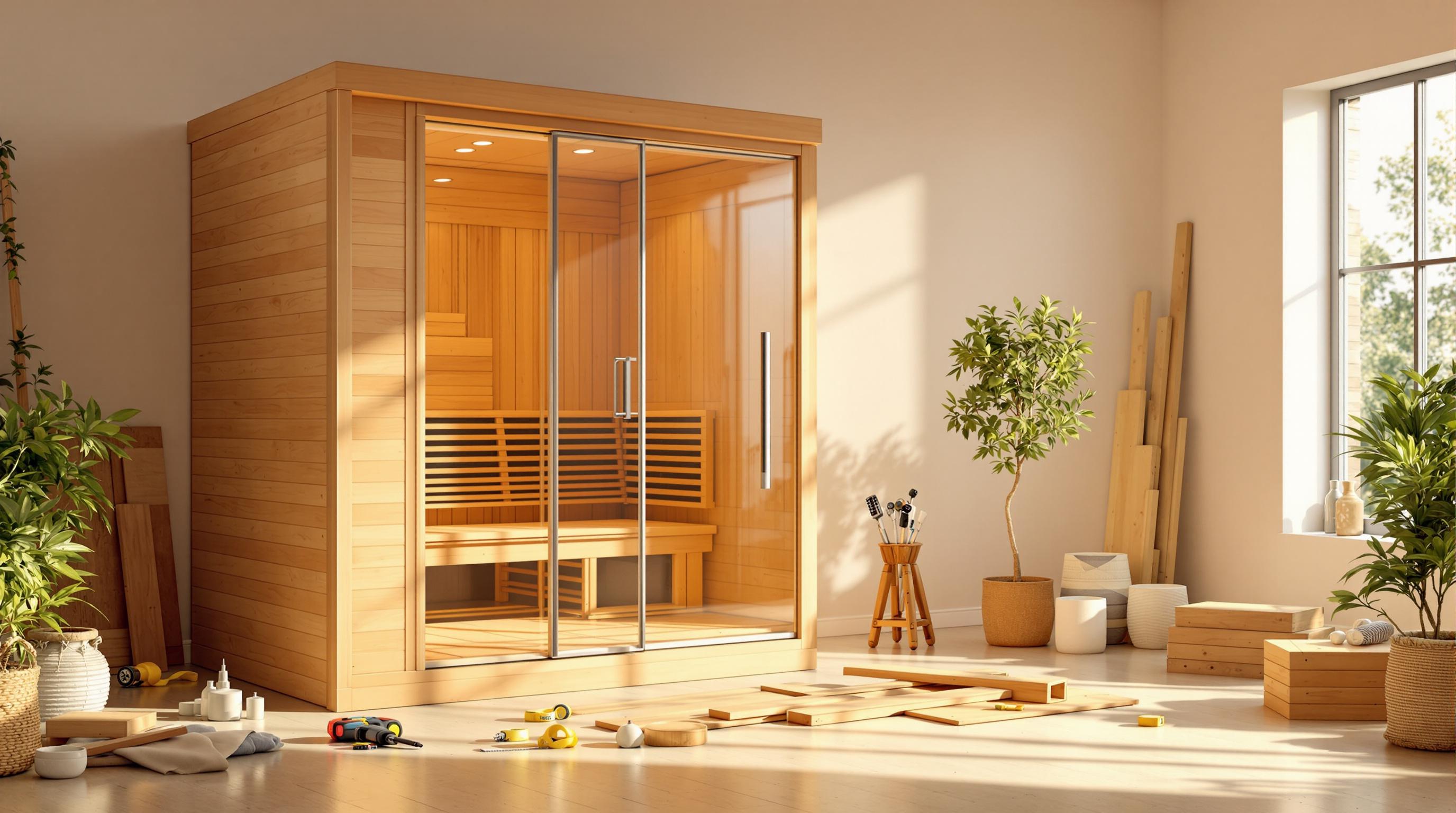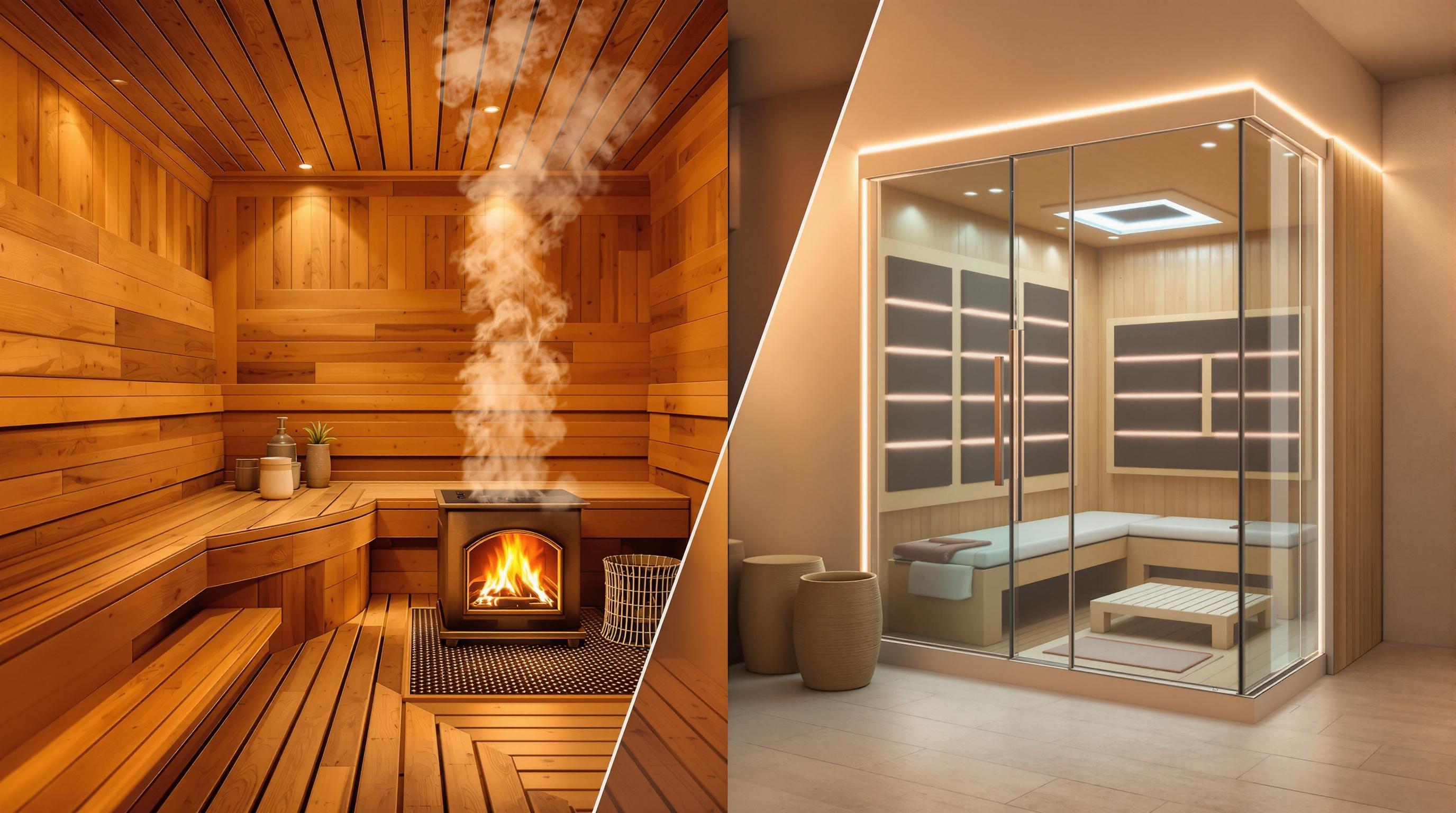Saunas heat up at different speeds depending on their type, size, and heating system. Here's a quick breakdown:
- Infrared saunas: Heat up in 10–20 minutes, operating at 120–150°F.
- Electric saunas: Take 15–45 minutes, depending on size, with temperatures of 150–195°F.
- Wood-burning saunas: Require 60–90 minutes to heat up due to manual fire preparation.
- Portable saunas: Warm up in just 5–10 minutes.
Factors like insulation, heater power, and location (indoor vs. outdoor) also affect heat-up times. For faster heating, ensure proper insulation, clean equipment regularly, and match the heater size to your sauna's dimensions.
Quick Comparison:
| Sauna Type | Heat-Up Time | Operating Temperature |
|---|---|---|
| Infrared | 10–20 minutes | 120–150°F |
| Electric (1-2 ppl) | 15–25 minutes | 150–195°F |
| Electric (5-6 ppl) | 30–45 minutes | 150–195°F |
| Wood-Burning | 60–90 minutes | 150–195°F |
| Portable | 5–10 minutes | Varies |
For the best experience, wait until the sauna reaches its ideal temperature before stepping in. Regular maintenance and efficient setup can save time and energy.
Heat-Up Times by Sauna Type
Electric and Wood-Burning Saunas
Electric and wood-burning saunas heat both the air and the stones, with heating times depending on the sauna's size. Smaller models (1-2 person) usually take about 15-25 minutes, while larger ones (5-6 person) may need up to 45 minutes [1]. Electric saunas tend to provide more consistent and efficient heating compared to wood-burning options [2]. This process creates the humid heat that traditional saunas are known for.
| Sauna Size | Heat-Up Time |
|---|---|
| 1-2 Person | 15-25 minutes |
| 3-4 Person | 20-35 minutes |
| 5-6 Person | 30-45 minutes |
Infrared Sauna Times
Infrared saunas heat up faster, reaching temperatures between 120-150°F in just 10-20 minutes. Unlike traditional saunas, these directly warm the body instead of the surrounding air [1]. This makes them more energy-efficient and a better option for users sensitive to high heat. While infrared saunas focus on speed and lower temperatures, steam rooms offer a very different experience with their high humidity and slower preparation times.
Steam Room Heating
Steam rooms take anywhere from 20 to 45 minutes to reach their ideal conditions, depending on their size and the generator's capacity. The longer heating time is due to the need to heat water, produce steam, and stabilize humidity levels. Steam rooms operate at lower temperatures than saunas but maintain nearly 100% humidity, offering a distinct experience. Knowing these differences can help you decide which type best suits your routine and preferences.
What Affects Heating Speed
Room Size and Wall Quality
The size of your sauna plays a major role in how quickly it heats up. Larger saunas take more time and energy to reach the desired temperature. Proper insulation is also key - materials like fiberglass or mineral wool help reduce heat loss and make warm-up times faster [3].
| Sauna Volume | Recommended Heater Power | Average Heat Time |
|---|---|---|
| Small (100-150 cu ft) | 4-6 kW | 15-25 minutes |
| Medium (150-250 cu ft) | 6-8 kW | 20-35 minutes |
| Large (250-400 cu ft) | 8-12 kW | 30-45 minutes |
The layout and location of your sauna also play a part in how efficiently it heats.
Location and Weather Effects
Indoor saunas generally heat up faster because they’re in a controlled environment where temperatures are steady. Outdoor saunas, on the other hand, have to contend with external factors like cold weather, which can slow down heating times [2]. The temperature difference between inside and outside can make a noticeable impact.
Heater Power Output
The heater’s power output, measured in kilowatts (kW), is another crucial factor. A good rule of thumb is to use 1 kW for every 45 cubic feet of sauna space [3]. If the heater is too small, it will struggle to maintain the right temperature. On the flip side, an overly powerful heater can waste energy and cause uncomfortable temperature swings [1].
Choosing Between Wood and Electric Sauna Stoves: What's Best for You?
Speed Up Your Sauna Heating
Getting your sauna to heat up quickly and efficiently not only saves time but also helps manage energy use. Here are some practical tips to ensure your sauna reaches the perfect temperature faster.
When to Start Heating
The preheating time depends on the type of sauna you have:
- Infrared saunas: Heat up in just 10–20 minutes.
- Traditional electric saunas: Need about 20–30 minutes to warm up.
- Wood-burning saunas: Take the longest, requiring 60–90 minutes because of the manual heating process [1].
Keep Equipment Clean
Regular upkeep is essential for maintaining good heating performance. Replace sauna stones every 1–2 years to ensure proper heat transfer. Clean and inspect your equipment regularly to avoid any drop in efficiency.
Air Flow and Stone Setup
The way you arrange sauna stones and manage airflow makes a big difference in heating speed. Here’s how to do it right:
- Place larger stones at the bottom and smaller ones on top.
- Leave enough space between stones for air to circulate effectively.
- Position the heater slightly above the ground and adjust vents to improve heat distribution [3].
For wood-burning saunas, make sure your firewood is properly prepared, and manage airflow to optimize the heating process. Small adjustments can lead to noticeable improvements in efficiency.
sbb-itb-3953eb0
Common Heat-Up Questions
Using a Partially Heated Sauna
You can step into a sauna before it’s fully heated, but it’s better to wait until it reaches at least 150°F for traditional saunas or 120°F for infrared saunas [1]. Entering too soon might result in uneven heat and limit the sauna’s benefits since the stones won’t be hot enough to create proper steam.
Signs Your Sauna is Ready
To ensure your sauna is ready, rely on its thermometer and look for these signs:
| Temperature Type | Ideal Range | Signs of Readiness |
|---|---|---|
| Traditional Sauna | 150-195°F | Thermometer shows steady reading, steam forms easily |
| Infrared Sauna | 120-150°F | Consistent temperature display, surfaces feel warm |
Check for a warm, humid environment when you open the door. For traditional saunas, the stones should sizzle and produce steam when water is poured on them. Waiting for full heat ensures a better experience and avoids wasting energy on underwhelming sessions.
Power Usage and Costs
Heating time impacts your energy bill. Larger saunas (5-6 person) need about 30-45 minutes to heat up, while smaller ones (1-2 person) take around 15-25 minutes [3].
Want to save on energy? Try these tips:
- Improve Insulation: Good insulation keeps heat in and shortens warm-up time.
- Use the Right Heater: Match the heater size to your sauna’s dimensions.
- Plan Sessions Smartly: Schedule back-to-back sessions to use residual heat.
"Regular maintenance, such as cleaning the heater and vents, ensuring proper insulation, and using a higher-powered heater can significantly reduce heating times and energy consumption [2]."
Conclusion
Knowing how long it takes for a sauna to heat up can help you plan better and choose the right type for your needs. Traditional saunas usually take about 30-40 minutes to heat, while infrared saunas are much quicker, reaching the desired temperature in just 10-15 minutes [1].
Among the different types, infrared saunas heat up the fastest. Electric and wood-burning saunas take longer but provide a more classic sauna experience. Traditional saunas typically operate at 150-195°F, while infrared saunas work at a lower range of 120-150°F [3].
Energy efficiency plays a big role in keeping operating costs down. Factors like insulation, heater power, and regular upkeep are key to ensuring your sauna heats effectively and maintains the right temperature. Paying attention to these details can make a big difference in performance and cost over time.
The right sauna for you depends on your schedule, preferences, and available space. Infrared saunas are perfect for those with busy lifestyles, thanks to their quick heating and lower operating costs. On the other hand, traditional saunas offer a more classic experience, though they require more time to heat. To explore options and find the best fit for your needs, check out Find the Home Sauna of Your Dreams.
Find the Home Sauna of Your Dreams

Choosing the right sauna starts with understanding how well it heats. Top Home Sauna makes this process easier by focusing on heating performance and user preferences.
The platform breaks down the key factors that influence heating efficiency and energy use. It highlights important features like temperature control, insulation quality, and power specs to guide you toward the best option.
Here are some heating features to keep in mind:
- Temperature control systems for precise adjustments
- High-quality insulation to retain heat effectively
- Power requirements to match your energy setup
- Size options suited to your available space
With a filtering tool that lets you search by heating needs and detailed product descriptions covering energy ratings and running costs, Top Home Sauna ensures you can make an informed choice. Their guides also provide tips for selecting a sauna that fits your daily routine and heating preferences.
Dive into these tools and features to discover a sauna that matches your lifestyle.
FAQs
How long does it take to heat up a sauna?
The time it takes to heat a sauna depends on its size and type. For a small sauna (1-2 people), it typically takes 15-25 minutes. Medium-sized saunas (3-4 people) usually need 20-35 minutes, while larger ones (5-6 people) may take 30-45 minutes. Factors like insulation, the surrounding temperature, and the heater's power can also influence heating times. Choosing a sauna with efficient heating can save both time and energy.
Which type of sauna heats up the quickest?
Infrared saunas are the quickest to heat, reaching their ideal temperature in just 10-20 minutes. This is because they directly warm the body rather than the air. Traditional saunas, on the other hand, usually take 30-40 minutes to fully heat up [1][3]. Knowing these differences can help you pick the sauna that best suits your lifestyle and schedule.


